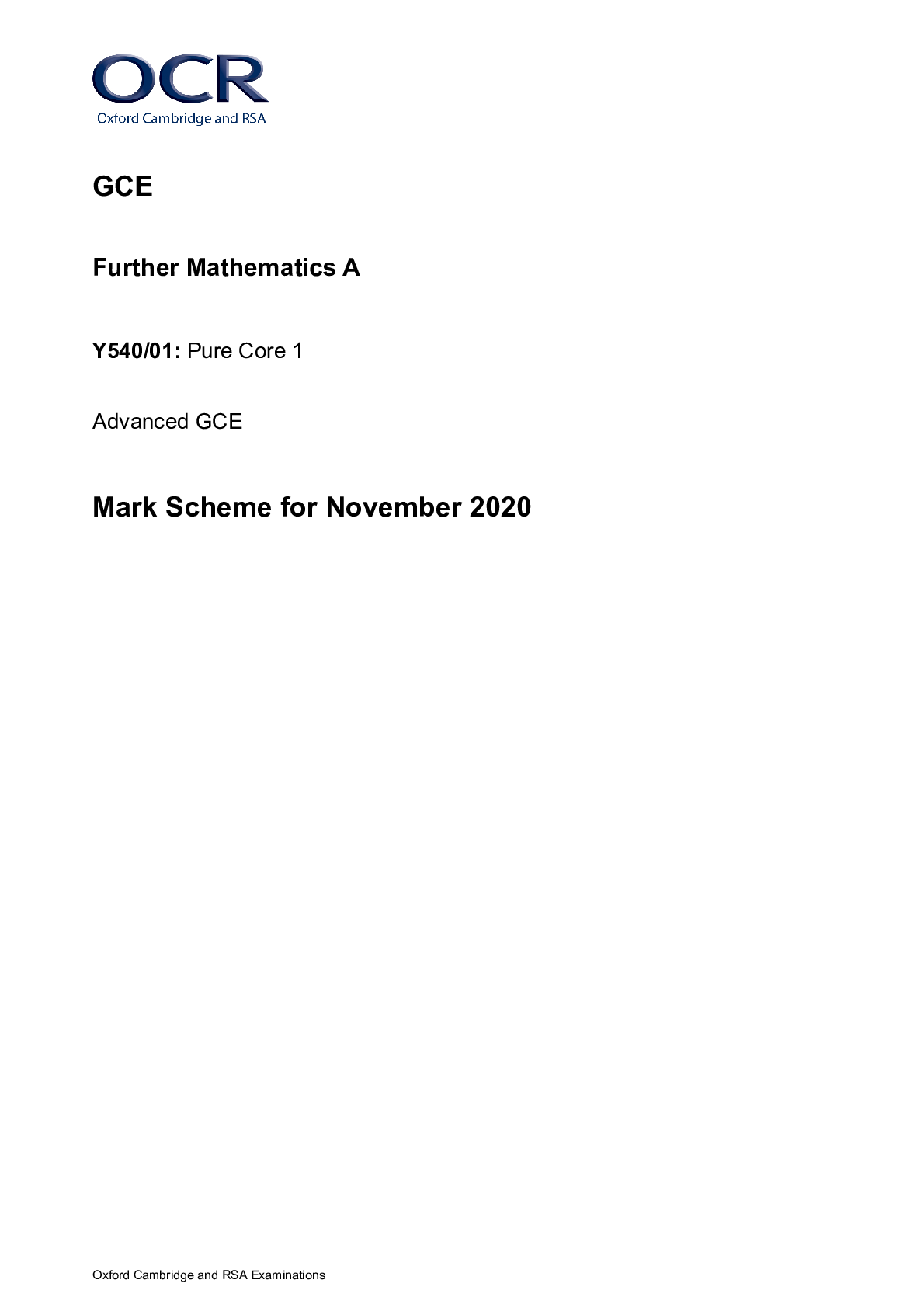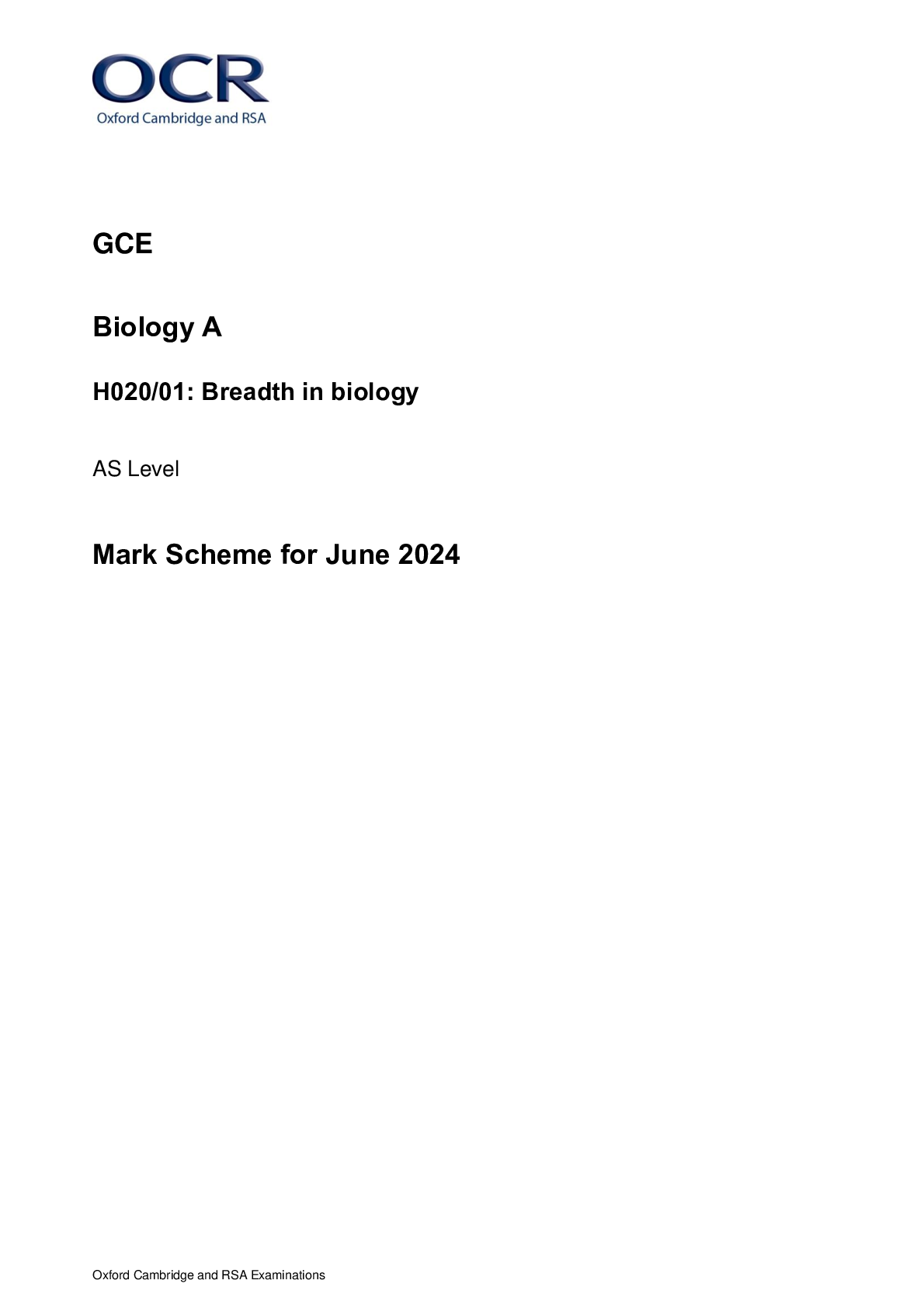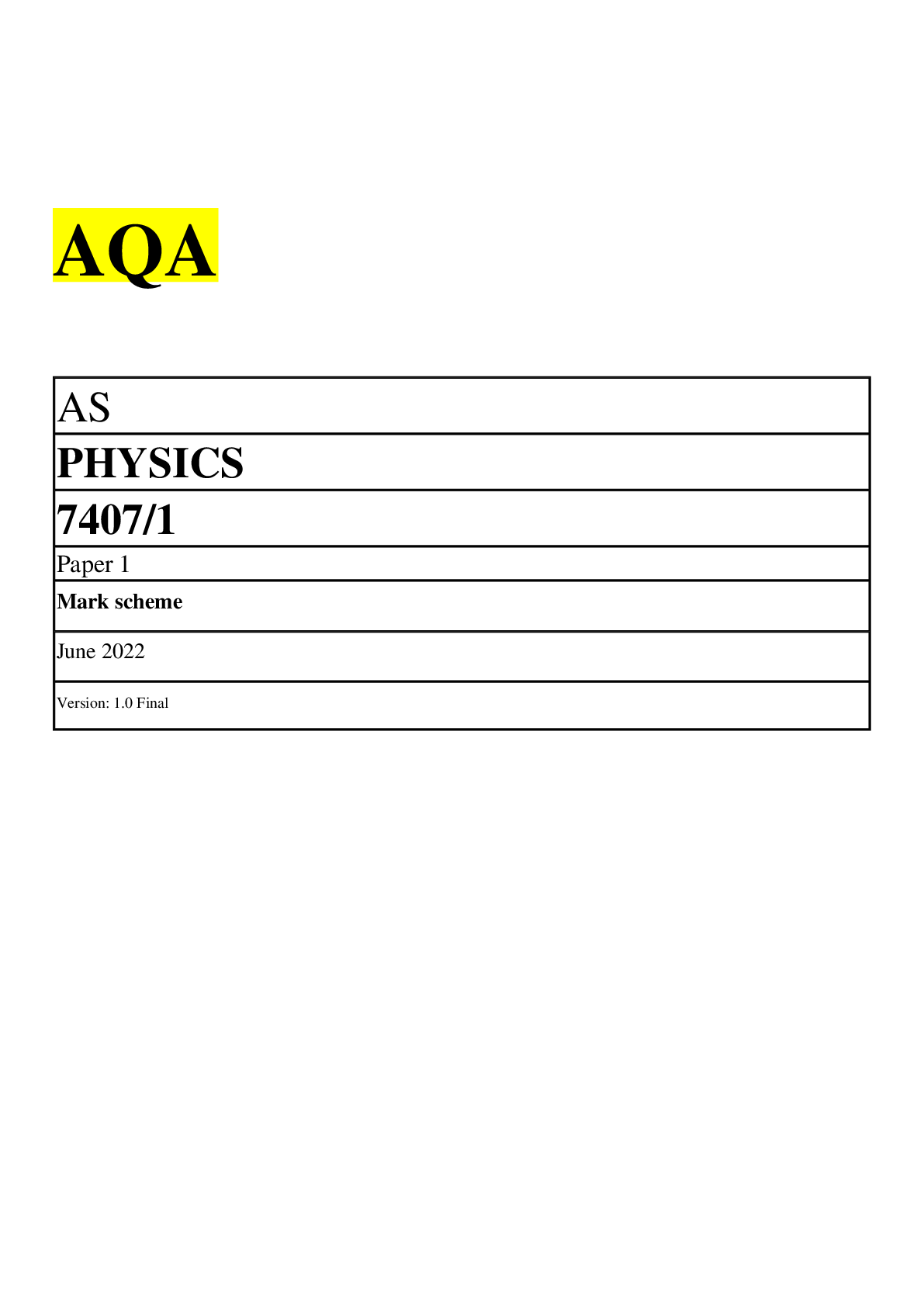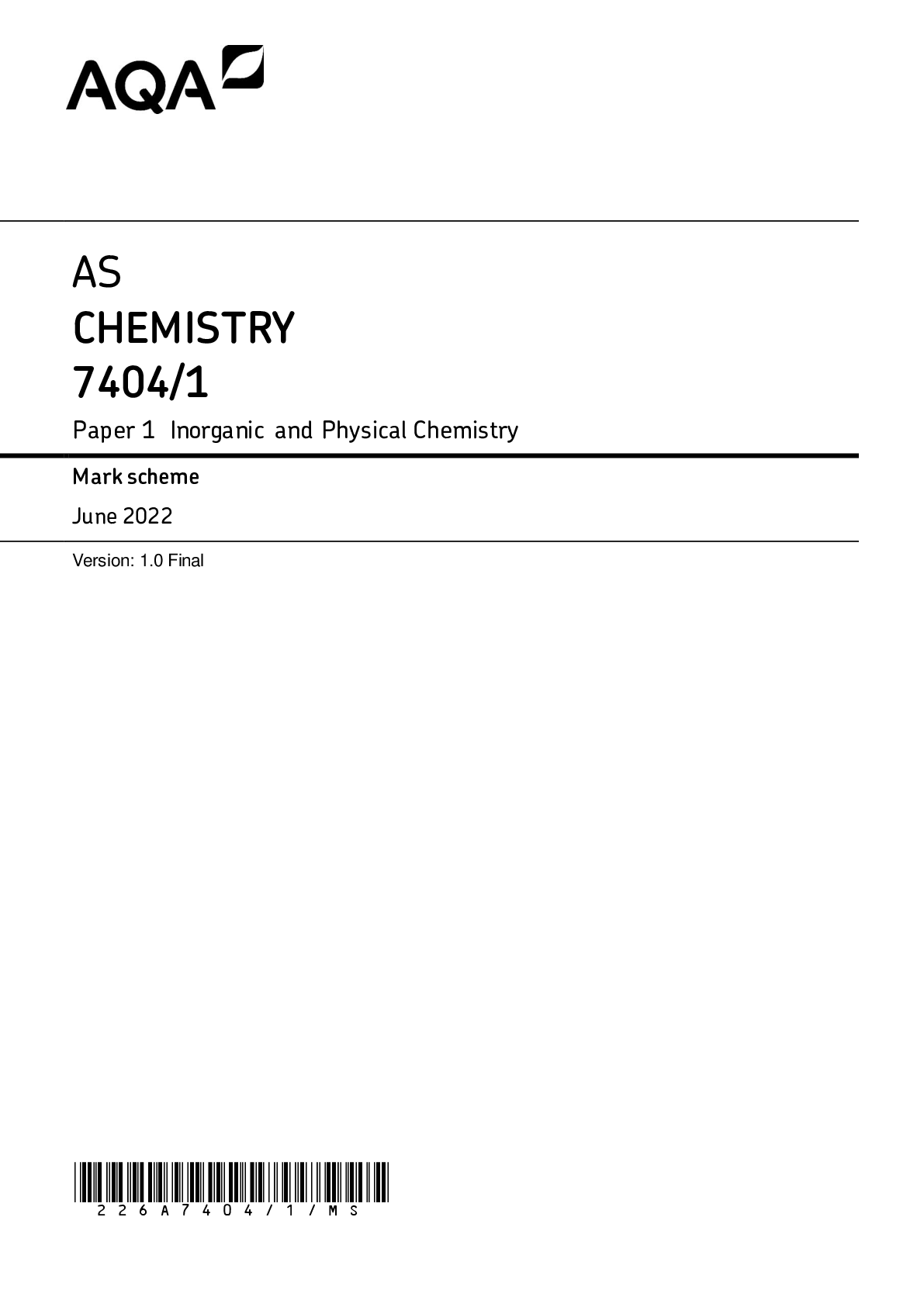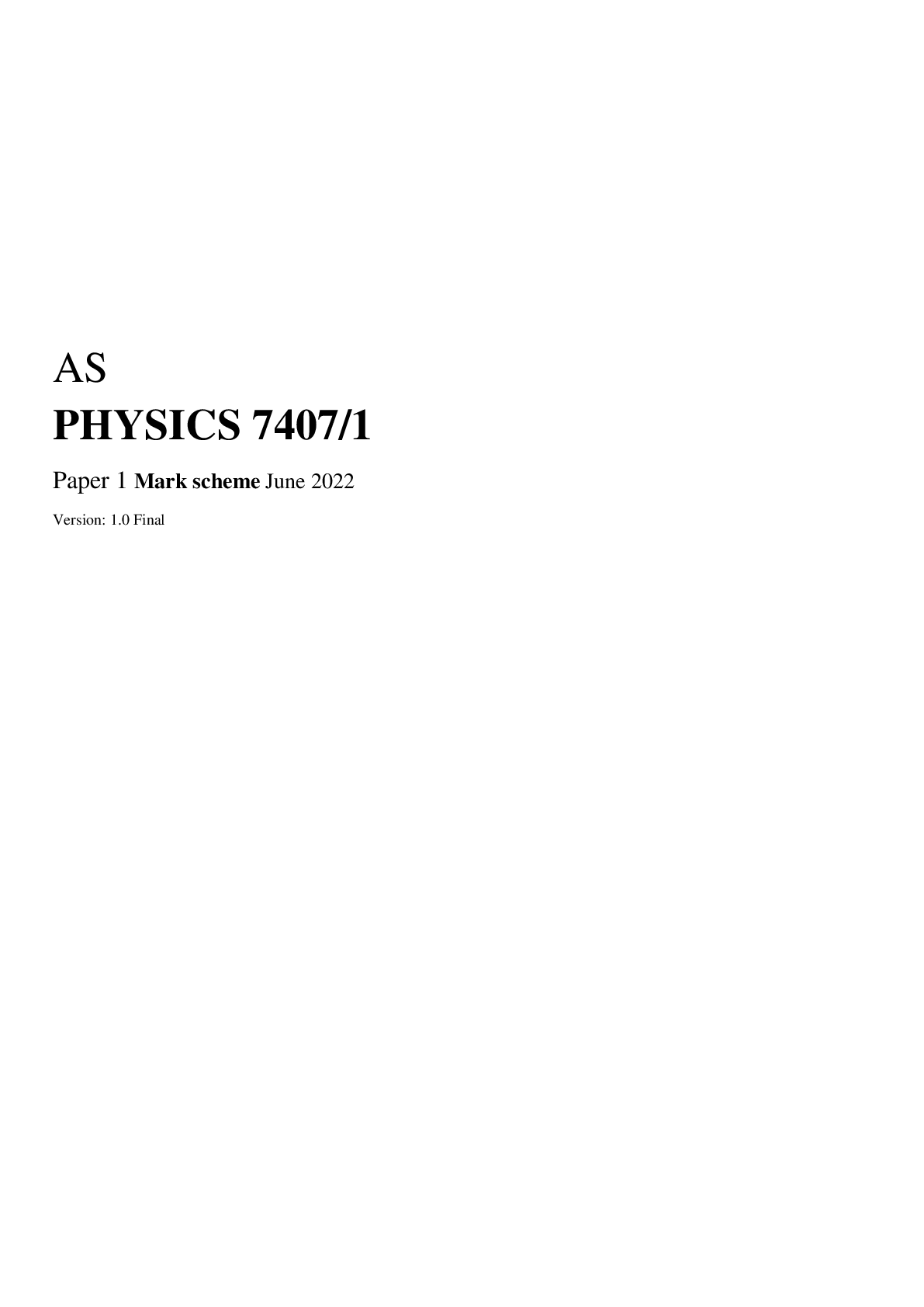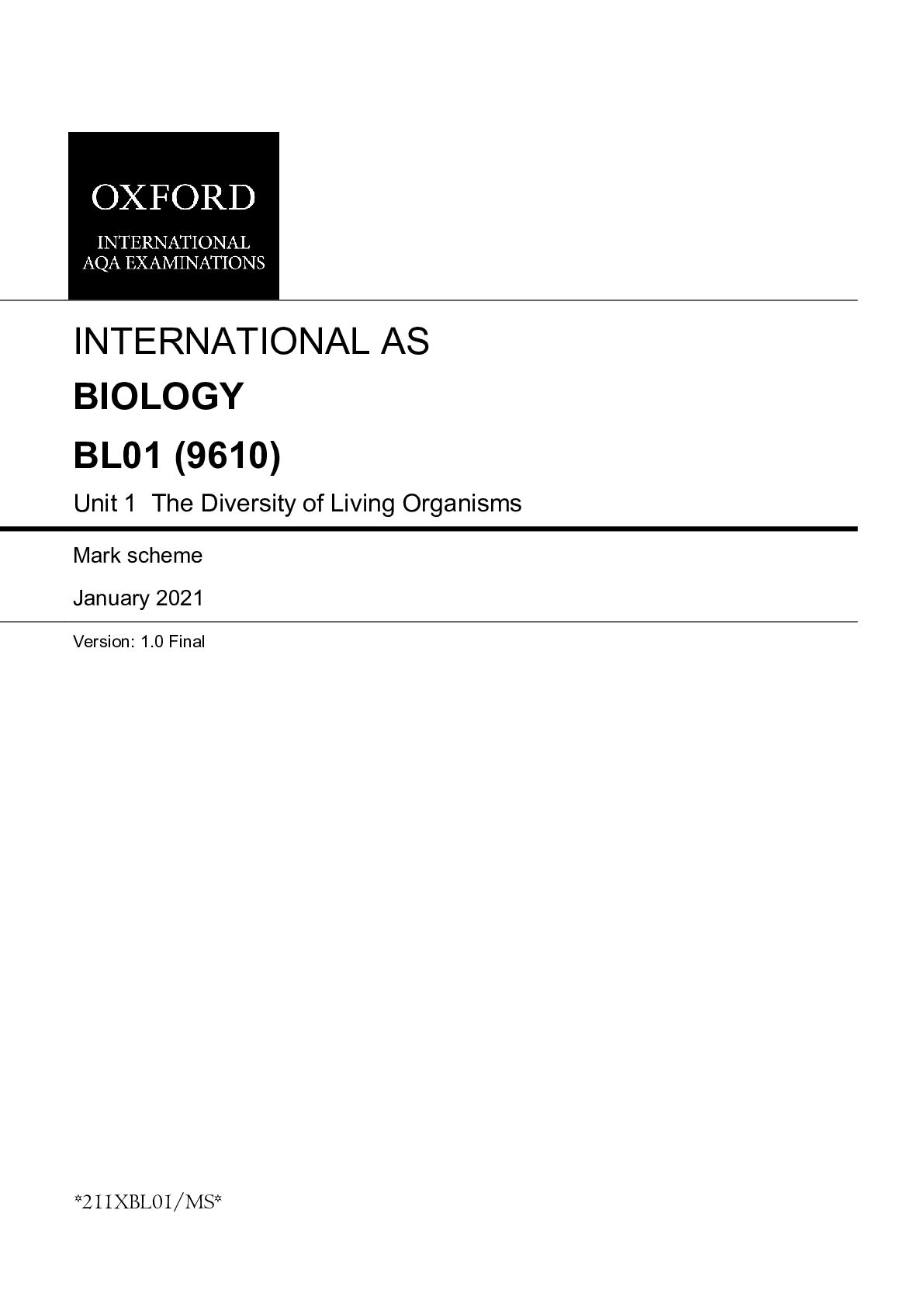Design and Technology > AS Mark Scheme > GCE Design and Technology H406/01: Principles of Product Design Advanced GCE Mark Scheme for Autumn (All)
GCE Design and Technology H406/01: Principles of Product Design Advanced GCE Mark Scheme for Autumn 2021
Document Content and Description Below
Oxford Cambridge and RSA Examinations GCE Design and Technology H406/01: Principles of Product Design Advanced GCE Mark Scheme for Autumn 2021Oxford Cambridge and RSA Examinations OCR (Oxford Ca ... mbridge and RSA) is a leading UK awarding body, providing a wide range of qualifications to meet the needs of candidates of all ages and abilities. OCR qualifications include AS/A Levels, Diplomas, GCSEs, Cambridge Nationals, Cambridge Technicals, Functional Skills, Key Skills, Entry Level qualifications, NVQs and vocational qualifications in areas such as IT, business, languages, teaching/training, administration and secretarial skills. It is also responsible for developing new specifications to meet national requirements and the needs of students and teachers. OCR is a not-for-profit organisation; any surplus made is invested back into the establishment to help towards the development of qualifications and support, which keep pace with the changing needs of today’s society. This mark scheme is published as an aid to teachers and students, to indicate the requirements of the examination. It shows the basis on which marks were awarded by examiners. It does not indicate the details of the discussions which took place at an examiners’ meeting before marking commenced. All examiners are instructed that alternative correct answers and unexpected approaches in candidates’ scripts must be given marks that fairly reflect the relevant knowledge and skills demonstrated. Mark schemes should be read in conjunction with the published question papers and the report on the examination. © OCR 2021H406/01 Mark Scheme October 2021 1. Annotations Annotation Meaning Blank Page – this annotation must be used on all blank pages within an answer booklet (structured or unstructured) and on each page of an additional object where there is no candidate response. Tick Cross Confused (replaces the question mark) Benefit of doubt AO1 – Knowledge and understanding AO2 – Apply knowledge and understanding AO3 – Analyse AO4 - Evaluation Omission Not answered question Noted but no credit given Too vague Own figure ruleH406/01 Mark Scheme October 2021 3 Repetition 2.Subject Specific Marking Instructions INTRODUCTION Your first task as an Examiner is to become thoroughly familiar with the material on which the examination depends. This material includes: • the specification, especially the assessment objectives • the question paper • the mark scheme. You should ensure that you have copies of these materials. You should ensure also that you are familiar with the administrative procedures related to the marking process. These are set out in the OCR booklet Instructions for Examiners. If you are examining for the first time, please read carefully Appendix 5 Introduction to Script Marking: Notes for New Examiners. Please ask for help or guidance whenever you need it. Your first point of contact is your Team Leader.H406/01 Mark Scheme October 2021 4 Question Answer Mark Guidance 1 (a) (i) Possible smart materials may include: • Nickel titanium (Nitinol/shape memory alloy/SMA) in frame of the glasses (1). It can be bent (sat on) and will not break (1). • Photochromic pigments in lens (1). They could be added to turn the glasses into sunglasses in the UV light (1). • Self-healing material or coatings (1). This can prevent corrosion and self-heal after small cracks/scratches from impact of being dropped/used outdoors (1). • Polymorph in nose pads (1). This can be used to shape to different people’s noses/prevent slippage (1). Any other valid suggestion of a smart material that changes/reacts to stimuli and changes – must be related to improving functionality and usability of glasses. 4 In each case: One mark for identifying a smart material. One mark for justifying why this smart material could have been used in the manufacture of the glasses. Specific reference to the context in the question is needed for marks to be awarded. No marks for simple one word responses e.g. ‘polymorph’. (ii) Possible negative implications may include: • Adding smart materials in the manufacture of the glasses may make the glasses harder to be recycled (1) as the materials will not be as pure (1), therefore will be harder to reform and re-use. (1) • The materials may take longer to decompose (1) Glasses have become items that are regularly changed and updated (1), so they are more likely to have a short shelf life (1). • This will be a more complex manufacturing process (1) which would increase the cost (1) making the glasses more expensive/ give the company less profit (1) • Any other valid suggestion. 3 One mark for identifying a negative implication of using smart materials in the manufacture of the glasses. Up to two marks for an explanation of this negative implication. Specific reference to the context in the question is needed for marks to be awarded. Max two marks awarded for two separate implications stated.H406/01 Mark Scheme October 2021 5 (iii) Possible explanations may include: • The glasses could be designed to be upgraded (1) with removable parts that could be changed to follow changes in fashion or prescriptions (1). • The glasses could be designed with interchangeable parts (1) so that they can grow with the user (1). • The glasses could be recycled (1) and manufactured into other products (1). • The glasses could use standardised components (1) so that when a part breaks, it can be easily sourced and replaced (1). Any other valid suggestion to include the reinforcing of specific parts e.g. arms or lenses or changing materials of specific parts to extend the life of the glasses can be credited, 6 In each case: Up to two marks for explaining how the useful life of the glasses could be extended. Specific reference to the context n the question is needed for marks to be awarded. No marks awarded for answer linked to consumer habits. (b) (i) 42+5+26+32 = 105 (1) 42/105 or 2/5 or 0.4 (1) 2 Award two marks as follows: One mark for calculating the overall frequency. One mark for calculating the relative frequency of someone only wearing glasses. If correct answer is given without working out shown award full marks. Where an incorrect answer is given working out should be used to credit appropriate marks. (ii) 0.4 x 30 000 = 12 000 (1) 1 One mark for estimating the number of people who would wear glasses in a population of 30 000 people.H406/01 Mark Scheme October 2021 6 (c) Indicative content: Possible responses of the role of business enterprise in developing new product ideas could include: • Entrepreneurship The process of designing, launching and running a new business, which has huge implications on the entrepreneur who is responsible not only for the success but the failure of decisions made. • Richard Branson started with selling records from his home using his own money and self-determination, learning from his mistakes and developed his brand to be very successful. • Commercial Partnerships Creating partnerships that can be mutually beneficial, sharing ideas, expertise and gaining access to new technologies and markets. This can create problems if different parties have conflicting ideas or principles. • 2004 Anglepoise lamp, developed by Sir Paul Smith from engineer George Carwardine’s original. • Coca-Coca and Emeco collaborating to up cycle waste bottles • Coca- cola sharing plant bottle technology with Ford and Heinz • Nike and Apple to create active wear that tracks activities. • Venture capitalists and crowd funding websites Investment into small businesses or people with great ideas from venture capitalists and crowd funding. • Dragons den • Kickstarter • Quirky • Any other valid suggestion. 8 For MB3 to be awarded two or three ways business enterprise can be used to develop new product ideas are discussed. If candidate does not provide an analytical/ evaluative response then only L1 can be awarded. Level 3 [6-8 marks] The candidate has a clear understanding of business enterprise. They produce a thorough discussion in relation to the question by explaining the role of business enterprise in developing new product ideas. The explanation of the role of business enterprise is clear and welldeveloped and different examples are used to exemplify the points being made. Level 2 [3-5 marks] The candidate has a reasonable understanding of business enterprise. They produce a sound discussion in relation to the question by explaining the role of business enterprise in developing new product ideas. The explanation of the role of business enterprise is sufficient although one or two opportunities are missed in providing different perspectives. Level 1 [1-2 marks] The candidate has a basic knowledge of business enterprise. Any reference to the role of business enterprise in developing new products is largely descriptive in nature. The response contains no analysis or evaluation. 0 marks No response or no response worthy of credit.H406/01 Mark Scheme October 2021 7 2 (a) (i) Possible modern materials may include: • PLA (1). Suitable for disposal packaging as it is fully biodegradable/ compostable (1). • Starch-based or plant-based biopolymers (1). This modern material is renewable/sustainable and therefore will reduce carbon footprint (1). • Any other valid suggestion. 2 One mark for identifying a suitable modern material. One mark for justifying why the chosen modern material is suitable. Accept bioplastic. Specific reference to the context in the question is needed for marks to be awarded. (ii) Possible disadvantages may include: • Biopolymers will not biodegrade in a landfill (1) and need to be in the right conditions to decompose (1). • Contamination of recycling schemes (1) makes the material less likely to be recycled/ the process more difficult/available e.g. terracycling (1) • Encourages people to litter as they believe the cup will decompose in nature (1) and do not understand this will take time (1). • Biopolymers made from plants and the planting and harvesting (1) of these could affect or displace wildlife or natural habitats (1) • Any other valid suggestion. 2 Up to two marks for explaining a disadvantage of using the modern material for the cup. Specific reference to the context in the question is needed for marks to be awarded. Max of 1 mark if the candidate gives a disadvantage of their chosen material in i) but it is not a modern materialH406/01 Mark Scheme October 2021 8 (b) (i) 5 Award five marks as follows: One mark for correct position on page in relation to front and side view\ orthographic layout. One mark for correct measurements without detail of lip One mark for correct plan without detail of lip One mark for detail of lip. One mark for line quality.H406/01 Mark Scheme October 2021 9 (ii) 155 – 135 / 2 = 10mm (1) 180-101 = 79 degrees (1) Tan 79* = opp/10 (1) Tan 79* x 10 = 51.446 (1) 51.446* x 2 + 4 (1) = 106.89 mm (1) 6 Award six marks as follows: One mark for calculating one side of triangle. One mark for calculating the angle to be used. One mark for recalling the correct trigonometry formula to use. One mark for applying the correct trigonometry formula. One mark for calculating the height of the burger carton. One mark for knowing that the height will include the size of the lip. If correct answer is given without working out shown award full marks. Where an incorrect answer is given working out should be used to credit appropriate marks. *Allow error carried forward (ECF) where correct working out is shown.H406/01 Mark Scheme October 2021 10 (c) (i) Possible responses may include: • The polyethylene lining makes the cardboard water resistant (1), making the cup last longer/less likely to leak (1). • The double walled paper board provides insulation (1) protecting the user’s hands from getting too hot/keeping drink warm (1). • The lid closes the cup (1) to reduce the chance of spillage/keeps the drink hotter for longer (1). • Any other valid suggestion. 2 One mark for identifying a feature of the cup that makes it suitable for hot drinks. One mark for justifying why this feature impacts suitability. Specific reference to the context in the question is needed for marks to be awarded. No marks for repeating the features in the question without linking it to the question: e.g. The PE lining (0) Removable PS lid (0) Double walled paper board (0). (ii) 2:3 1 One mark for calculating the ratio of the small to medium cup. (iii) 360 – 240 = 120 (1) 360 + 120* = 480 ml (1) The answer could be calculated using a ratio-based approach. 2:3:4 = 9 9 x 120 = 1080 1080 – 240 – 360 = 480 ml 2 Award two marks as follows: One mark for calculating the mark up. One mark for calculating the volume that the large cup holds in ml. If correct answer is given without working out shown award full marks. Where an incorrect answer is given working out should be used to credit appropriate marks.H406/01 Mark Scheme October 2021 11 *Allow error carried forward (ECF) where correct working out is shown but mark-up is calculated incorrectly. 3 (a) Possible responses may include: Electrical item: • BSi/CE mark (1) British/European standards kitemark to say it has met certain safety standards (1) • Crossed out bin symbol (1) WEEE directive symbol indicates that it needs to be disposed of at a separate facility than normal household waste (1). • Any other valid suggestion. Aerosol can: • Flammable symbol (1), warning users to keep away from the heat (1). • Harmful or irritant symbol (1) warning users that it may irritate the users skin (1). • Any other valid suggestion. 4 In each case: One mark for identifying an example of a symbol you would expect to find on a label for the stated products. One mark for justifying why this would be included. Specific reference to the context in the question is needed for marks to be awarded. If candidates have drawn the correct symbol award mark. Do not reward if same response given for all three products.H406/01 Mark Scheme October 2021 12 (b) * Indicative content: • Ensuring that the workplace is safe and without risk. This can be done with regular risk assessments and control measures put in place. This could be with clear signage and zones. • Machinery must be safe and procedures of work are set and followed. There needs to be a logged set of checks on a regular basis. • Providing safe equipment and PPE e.g. correct dust masks for cutting MDF/ goggles/visors/gloves etc. • Providing first aid stations and logging accidents. • COSHH regulations should be adhered to and risks minimised. Ensuring that chemicals are locked in a flammable liquids cupboard and spill kits are available. • Up to date training for all staff. • All of these measures will have a cost and time implication however they will prevent larger implications of putting employees and an unnecessary risk, potential tragic accidents and liability. Any other valid suggestion. 8 For MB3 to be awarded two or three implication s of specified legislation are discussed. If candidate does not provide an analytical/ evaluative response then only L1 can be awarded. Level 3 [6-8 marks] The candidate has a clear understanding of health and safety legislation. They produce a thorough discussion in relation to the question by explaining the implications for manufacturers of health and safety legislation. The explanation of implications is clear and well developed and a number of examples are used to exemplify the points being made. There is a well-developed line of reasoning which is clear and logically structured. The information presented is relevant and substantiated with the use of examples. Level 2 [3-5 marks] The candidate has a reasonable understanding of health and safety legislation. They produce a sound discussion in relation to the question by explaining the implications for manufacturers of health and safety legislation. The explanation of implications is sufficient although one or two opportunities are missed in providing different perspectives. There is a line of reasoning presented with some structure. The information presented is for the most part relevant and supported by some evidence.H406/01 Mark Scheme October 2021 13 Level 1 [1-2 marks] The candidate has a basic knowledge of health and safety legislation. Any reference to the implications of health and safety legislation on manufacturers is largely descriptive in nature. The response contains no analysis or evaluation. The information has some relevance and is presented with limited structure or detail. The information is supported by limited evidence. 0 marks No response or no response worthy of credit.H406/01 Mark Scheme October 2021 14 4 (a) Possible features of the frying pan may include: • A hole in the handle (1) so that the frying pan can be hung up when not in use (1). • Smooth shiny surface (1) that can be easily cleaned (1) • Circular shape (1) which will cook food on a circular hob evenly (1). • Any other valid suggestion. 4 In each case: Up to two marks for describing a feature of the frying pan that improves its functionality. Specific reference to the context in the question is needed for marks to be awarded. Do not accept any reference to aesthetics. (b) Possible responses may include: • Aluminium (1). Resistant to corrosion so it will not rust when it is being washed/used repeatedly (1). • Good fast heat distribution which allows the food to be cooked efficiently (1). • Any other valid suggestion Other non-ferrous materials that are acceptable include copper with appropriate level of justification. 2 One mark for identifying a suitable non-ferrous metal for the manufacture of the frying pan. One mark for justifying why this nonferrous metal is suitable. Specific reference to the context in the question is needed for marks to be awarded. Do not accept aluminium alloy.H406/01 Mark Scheme October 2021 15 (c) (i) Indicative content: The candidate is expected to demonstrate their understanding of the process involved through a series of annotated sketches and/or notes. There may be variations to the process as indicated but to get into L3 candidates must demonstrate a clear understanding of the end to end process. Process: • Aluminium sheet prepared, steel die prepared • Disk stamped, hydraulic press to create the blank • Sheet metal clamped over female die (shape of part A) • Hydraulic male die pushes blank into female die with a punch • (Holes for handle could also be punched in at this stage or in additional stage) • Edges trimmed by cutting blade & edges rounded • Die opened and Part A removed • Turned on lathe & base machined flat • Any scrap recycled • Thickness of metal check in QC process. Defects removed. • Reference made to batch manufacture Alternative process could include spinning: • Aluminium sheet prepared • Disk stamped, hydraulic press to create the blank • Mandrel in the chuck • Blank held in between mandrel (shape of part A) and tail stock • Mandrel is spun and roller tool rolled along the blank to stretch the metal • Pressure is applied and tool is rolled over blank as it takes the form of the mandrel (shape of part A) • Excess trimmed & edges rounded. • Scrap recycled • Reference made to batch manufacture Any other valid suggestion. 5 All processes demonstra ted must relate to the product in the question. Casting can be awarded marks achieving a max level 2 Level 3 [4-5 marks] The candidate demonstrates a good level of detail of the process needed to manufacture the pan using technical terms and considering any relevant specialist tooling and quality control checks. Sketches, if used will be clear and supported with relevant notes. The process includes all relevant stages. Level 2 [2-3 marks] The candidate will demonstrate a sound level of detail of the process needed to manufacture the pan using some technical terms and there will be some consideration of any relevant specialist tooling and quality control checks. Sketches, if used, will for the most part be clear and supported with notes most of which are relevant. The process includes some relevant stages. Level 1 [1 mark] The candidate will demonstrate a limited level of detail of the process needed to manufacture the pan with a limited use of technical terms and there will be a basic consideration of any relevant specialist tooling and quality control checks. Sketches, if used, will be unclear with only basic notes to accompany them. Few relevant stages are included. 0 marksH406/01 Mark Scheme October 2021 16 Example of a level 3 response No response or no response worthy of credit.H406/01 Mark Scheme October 2021 17 (ii) Indicative content: The candidate is expected to demonstrate their understanding of the process involved through a series of annotated sketches and/or notes. There may be variations to the process as indicated but to get into L3 candidates must demonstrate a clear understanding of the end to end process. Process: • Aluminium sheet prepared • Handle stamped, hydraulic press to create the blank • Sheet metal clamped over female die (shape of part A) • Hydraulic male die pushes blank into female die with a punch • Holes punched in pan (Give credit if this is stated in part i) • Holes punched in handle • Holes aligned and clamped into place • Rivet shaft inserted • Set is placed over the head of the rivet • Rivet shaft hammered compressing the two parts together • Parts riveted together • Joint checked for strength and removed & recycled if doesn’t pass checks • Reference made to batch manufacture Any other valid suggestion 5 All processes demonstra ted must relate to the product in the question. Accept other permanen t joining processes . If TIG welding or use of bolts given as joining method max level 2 response Level 3 [4-5 marks] The candidate demonstrates a good level of detail of the process needed to manufacture the handle and appropriate method for joining it to the pan using technical terms and considering any relevant specialist tooling and quality control checks. Sketches, if used will be clear and supported with relevant notes. The process includes all relevant stages. Level 2 [2-3 marks] The candidate will demonstrate a sound level of detail of the process needed to manufacture the handle and appropriate method for joining it to the pan using some technical terms and there will be some consideration of any relevant specialist tooling and quality control checks. Sketches, if used, will for the most part be clear and supported with notes most of which are relevant. The process includes some relevant stages. Level 1 [1 mark] The candidate will demonstrate a limited level of detail of the process needed to manufacture the handle and appropriate method for joining it to the pan with a limited use of technical terms and there will be a basic consideration of any relevant specialist tooling and quality control checks. Sketches, if used, will beH406/01 Mark Scheme October 2021 18 Example of a level 3 response unclear with only basic notes to accompany them. Few relevant stages are included. 0 marks No response or no response worthy of credit.H406/01 Mark Scheme October 2021 19 (d) Possible responses may include: • Stress testing of the frying pan in use (1). The pan could be subjected to the correct temperatures to ensure it behaves as expected (1). • Durability analysis (1). The wear of the pan could be tested to see where damage may occur and for any weaker spot that may snap/leak (1). • Safety checks for components (1). Checking that the handle doesn’t get too hot/is difficult to hold when pan is in use (1). • Any other valid suggestion. 2 Up to two marks for describing a physical test that the frying pan would undergo to test performance. Specific reference to the context in the question is needed for marks to be awarded.H406/01 Mark Scheme October 2021 20 (e) Indicative content: • Mathematical modelling is used to optimise the design The results can also be presented as graphs and charts. • Generative design tools produce optimum forms e.g. Adidas 3D printing customised midsoles for their runners or airbus to achieve lightest, strongest design that uses the minimal amount of material. • Communication of ideas through visual presentation, rending and photo quality rendering. • Online collaboration to discuss and exchange ideas with experts and/or other designers. This could also include discussing ideas/ designs with stakeholders. • Product simulation and testing, and test weak areas that may fail, (Finite Element Analysis (FEA). • Scientific analysis of real-world physical factors to determine whether a product will work in the way it’s intended. This can also be used to optimise the design. • Rapid prototyping such as 3D printing can be used to test ideas. • Any other valid suggestion. . 6 For MB3 to be awarded two or three ways that digital design software can be used during design developm ent are discussed. If candidate does not provide an analytical/ evaluative response then only L1 can be awarded. Level 3 [5-6 marks] The candidate has a clear understanding of digital design software. They produce a thorough discussion in relation to the question by explaining the role of digital design software during design development. The explanation of the role of digital design software is clear and welldeveloped and different examples are used to exemplify the points being made. Level 2 [3-4 marks] The candidate has a reasonable understanding of digital design software. They produce a sound discussion in relation to the question by explaining the role of digital design software during design development. The explanation of the role of digital design software is sufficient although one or two opportunities are missed in providing different perspectives. Level 1 [1-2 marks] The candidate has a basic knowledge of digital design software. Any reference to the role of digital design software during design development is largely descriptive in nature. The response contains no analysis or evaluation. 0 marks No response or no response worthy of credit.OCR (Oxford Cambridge and RSA Examinations) The Triangle Building Shaftesbury Road Cambridge CB2 8EA [Show More]
Last updated: 3 years ago
Preview 1 out of 22 pages

Buy this document to get the full access instantly
Instant Download Access after purchase
Buy NowInstant download
We Accept:

Reviews( 0 )
$7.50
Can't find what you want? Try our AI powered Search
Document information
Connected school, study & course
About the document
Uploaded On
Oct 10, 2022
Number of pages
22
Written in
All
Additional information
This document has been written for:
Uploaded
Oct 10, 2022
Downloads
0
Views
221











